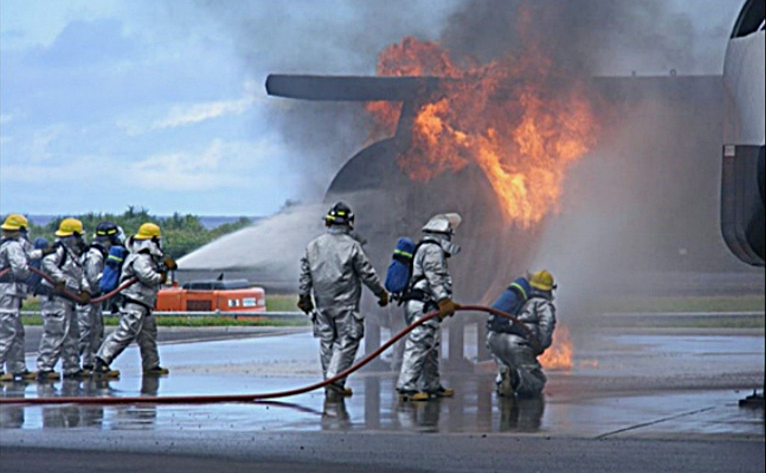Pago Pago is currently organized as an Index C Airport. The existing ARFF building is located on the north side of the runway at an approximate midfield location. The building contains five vehicle bays. Support and office space is located on the east-end of the building. Fire training facilities are also included in this area. These facilities are a necessary component of airport infrastructure and assist the airport in securing its operating license.
A new Hot Fire Training Facility (HFTF), located immediately north of the parallel taxiway serving Runway 5-23, was completed in July 2009. The Fire Training Facility at Pago Pago International Airport comprises a separate Simulated Aircraft Fire Trainer with multiple interior and exterior fires providing the full gambit of scenarios relating to incidents that firefighters may encounter with an aircraft while on the ground. There is a large spill fire area consistent with the requirements of an FAA regulated Index C airport that is multi-sectional enabling variation in the size of fire that is provided for trainees.

In order to facilitate the requirements to respond an airports structural fire requirements a two story burn building has been constructed to provide both fire training and a tactical rescue function. The facility is controlled from a centrally located tower that has the ability to both monitor conditions for the trainees and to institute failsafe control in the event of an emergency.
An added feature of the facility is that it provides aviation firefighters with the opportunity to fight hydrocarbon fires (Jet A1), an option that is not usually available with this type of training venue. The facility provides the opportunity to regionalize training and approaches have been made to neighboring countries to acquaint them with the ability to use the training center as a regional facility.
FAR Part 139.319 states the response time requirements in the event of an emergency at the airport. It states that within 3 minutes from the time of the alarm, at least one required ARFF vehicle must reach the midpoint of the farthest runway and begin application of required extinguishing agents. It also states that within 4 minutes of the alarm, all other required vehicles must reach this point. The airport currently complies with these requirements.
AIRCRAFT RESCUE AND FIREFIGHTING SERVICE
The Rescue and Firefighting Service located at Pago Pago International Airport in Tafuna is under the umbrella of the Department of Ports Administration. The fire station provides Index C coverage under the requirements of Federal Aviation Regulation Part 139 but has the vehicle capability to provide Index D coverage if required. The station is double bayed with the ability to house ten vehicles and has its own vehicle and breathing apparatus servicing facilities.
The service has three major 1500-gallonfrontline foam vehicles and a Rapid Intervention vehicle along with a Command and Control vehicle that can be located at an incident site to provide a Command Point.
A rostered system of four crews provide 24 hour coverage to the airport and its surrounding area by four crews who are ready to respond to all manner of emergency situations, including fire both aircraft and structural, hazardous materials, road accidents and situations that require rope rescue.
Training plays a prominent part in the service; this commitment to training is highlighted by the Hot Fire Training Facility that is immediately adjacent to the Fire Station. This state of the art facility allows the crews to train for all manner of aircraft and structural emergencies that they may encounter.
The Simulated Aircraft Fire Trainer (SAFT) and theinterior structural fire building provides real life training for wheel brake, engine, wing, pool and interior firefighting scenarios. This is especially advantageous as it allows crews from both the Department of Port Administration and the Department of Public Safety to work together in firefighting situations and build relationships that are vital when dealing with real time emergencies. This continuation training is driven by the responsibility firefighters carry as a team to the protection of the public.

No words better express the commitment a firefighter has than those of FDNY Chief Croker (1863 to 1951) “I have no ambition in this world but one and that is to be a fireman.”

